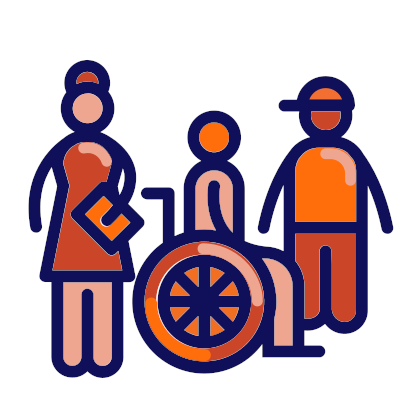Preventing bullying and violence

Schools can, and should, play a key role in tackling these abuses.
Whole-school anti-bullying programmes are needed, which promote peer support systems and involve active and well-trained teachers and parents, to foster a safe learning environment in which no violence is allowed.
Facts & figures
Half of the world’s students aged 13-15 say they have experienced violence in and around school.[1]
Nearly one in three students of this age say they have experienced bullying or been involved in fights.[2]
More than 700 million children have no legal protection from corporal punishment at school.[3]
What is violence and bullying?
Violence is the threatened or actual use of physical force or power resulting in physical or psychological harm to others.
Bullying is a form of violence. It can be defined as unwanted, aggressive behaviour which involves a real or perceived imbalance of power. It is behaviour that is repeated, or carries the threat of being repeated over time.
Bullying takes different forms in school, including:
- Physical, e.g., hitting, kicking, slapping, shoving, hair-pulling, etc.
- Verbal, e.g., name-calling, teasing, using belittling expressions, etc.
- Relational, e.g., ostracising, spreading rumours, social manipulation, etc.
- Sexual, e.g., sexual name-calling, uninvited touching, propositioning, etc.
Cyberbullying is a distinctive form of bullying. It differs from other types on account of the constant risk of public exposure, the complex roles of observers and the size of the audience that comes with digital technologies.[4].
Bullying is not the only form of student-on-student violence in schools, however. Fights between, and attacks on students associated with gang culture and the carrying of weapons, especially knives, are becoming an increasing problem in various countries.
Why is addressing violence and bullying important at school?
Under the U.N. Convention on the Rights of the Child, schools have a formal duty to protect children from all forms of violence, both physical and psychological.
“Parties shall take all appropriate legislative, administrative, social and educational measures to protect the child from all forms of physical or mental violence, injury or abuse, neglect or negligent treatment, maltreatment or exploitation, including sexual abuse, while in the care of parent(s), legal guardian(s) or any other person who has the care of the child.”[5]
Failure to protect children at school can have harmful repercussions on their future lives, both educationally and socially - whether they be victims, perpetrators or bystanders.
Students who are bullied are more likely to suffer from depression and anxiety, health issues, poor academic achievement and behaviour problems at school, including higher drop-out rates. A small number may also retaliate in violent ways. Students who bully others are more likely to exhibit other behaviour problems at school and to suffer from alcohol or drug abuse, and to engage in criminal activity and abusive relationships in adulthood. Children who witness bullying and violence are also more likely to have mental health difficulties and miss or drop out from school.
Violence and bullying not only affects academic learning, it also impacts negatively on the social development of young people. In particular, students who experience violence and bullying are more likely to have difficulty developing basic democratic competences, such as empathy, respect for others, openness to other cultures and beliefs, tolerance of ambiguity and self-efficacy – all of which lie at the heart of the Council of Europe Reference Framework of Competences for Democratic Culture.
The effects of violence and bullying are not limited only to the students directly involved, but potentially impact on everyone at a school. Unchecked, incidents of violence and bullying lead to an atmosphere of anxiety and insecurity incompatible with learning. They also lead to, or exacerbate conflicts beyond the school gates, which in turn have further consequences for relations within the school.
What are the challenges?
Violence and bullying can be challenging to deal with at school. What is regarded as bullying or violence is sometimes thought of as a matter of subjective opinion. It can be difficult to build a common approach to eradicating from school something which a significant proportion of staff believes not to exist or is not important to them.
The prevailing culture in a school can sometimes work against attempts to reduce violence in its different forms. Rule by fear, over-emphasis on punishment and the prioritization of learning environments which support competitive behaviour all militate against the prevention of violence and bullying. So, too, does the holding of an ideology which accepts violence as a valid response in situations of fear, stress or frustration – as evidenced in the advice commonly given to victims of bullying to fight back and give the bully a ‘taste of their own medicine.’
In such circumstances it can be easy to think that dealing with violence and bullying is simply a matter of stopping fights, giving punishments and imposing order, rather than questioning the wider culture of the school, the examples it sets and the sorts of behaviour it supports.
Many teachers are unaware of democratic approaches of dealing with violence and bullying, such as:
- restorative justice
- conflict resolution
- peer mediation.
Such approaches are not only arguably more effective than punitive ones, but also have the advantage of promoting democratic values and attitudes more widely across a school.
Such approaches take time to learn, however, and require the development of specific types of skills, knowledge and attitudes. They also take time to put into practice. It can be difficult for a teacher to find the time and motivation to deal with violence and bullying in a democratic and constructive way. It is easier just to punish the supposed perpetrator, and easier still to pass the perpetrator up the school hierarchy for a more senior member of staff to punish.
A further challenge in recent years has been the rise of gang culture among young people and the carrying of weapons, especially knives, in as well as out of school. This has led to a rise in the number of serious acts of violence between students and also to the more regular involvement of the police in school affairs, both of which demand new professional skills and ways of working from teachers and school leaders.
How can schools get active?
Taking action on violence and bullying is not just a matter of finding better ways of responding to incidents after they have occurred – though this is important, but also of creating the kind of school environment in which violent incidents are less likely to happen in the first place.
A good place to start is with asking students to review the current situation in their school:
- where they feel vulnerable or in danger
- where they feel safe
- what sorts of violence they have witnessed or experienced
- what they see as the causes of these sorts of violence
- how effective they think the school is at dealing with violence
- what further measures they would like the school to take.
Surveying student opinion provides a good evidence base for targeting measures to prevent violence, e.g., increasing supervision in areas in school where students are fearful of going, creating more opportunities for constructive play during breaks from lessons, etc.
It can also stimulate a whole-school conversation about violence and bullying. Such a conversation is important for arriving at a whole-school policy that everyone can support. It is an opportunity to develop a common language and understanding of what constitutes violence and bullying in school and shared rules on how to approach it, including the reporting and monitoring of incidents. This is why it is essential that the voices of all school stakeholders are heard in the process of policy-development: principals, teachers, students, parents and the local community.
The conversation should also include the opportunity for teachers to reflect on practices that lead to frustration and low self-esteem among students, such as an over-emphasis on competition, over-frequent assessment and unreasonably high expectations of academic attainment. Attention should be given instead to creating a school environment which encourages inclusion and co-operation, and the valuing of individual differences and diversity.
Reflection on current practice goes hand in hand with the provision of opportunities for school staff to develop new skills. The ability to recognise violence in all its forms and to be able to deal with it appropriately are important professional skills for any adult involved in school life.
As young people themselves are often the most effective agents for change in a school, it is important they should be involved in formal initiatives to reduce violence and bullying, such as peer mediation schemes. Such schemes are most effective when taken seriously by both staff and the students involved, for example, by instituting formal recruitment procedures for student mediators and opportunities for high-level training from someone with the appropriate professional expertise.
Initiatives of this kind can be supported in the classroom by making time in the curriculum to talk with students about issues of violence and bullying. It should include discussions about the psychology of bullying, the effects of peer pressure and the influence of social media on young people’s behaviour.
[1] UNICEF Report, September 2018
[4] de Morais & Fernandes, 2017. ‘When bullying crossleakes the screen’. In J. Richardson, E. Milovidov & R. Blamire (Eds.), Bullying: Perspectives, Practices and Insights (pp. 11-16). Strasbourg, France: Council of Europe.
 Resources on Preventing violence and bullying
Resources on Preventing violence and bullying
 Related schools projects
Related schools projects
Address:
Country: Cyprus
Project: Passengers on the Same Bus! No Discrimination, Segregation and Inequality!
 Working language during the project:
Working language during the project:
- English
 Themes of the Council of Europe campaign “FREE to SPEAK, SAFE to LEARN - Democratic Schools for All” covered:
Themes of the Council of Europe campaign “FREE to SPEAK, SAFE to LEARN - Democratic Schools for All” covered:
- Making children’s and students’ voices heard
- Preventing violence and bullying
- Tackling discrimination
- Improving well-being at school
 Competences from the Reference Framework of Competences for Democratic Culture (CDC) addressed and where / how they were integrated:
Competences from the Reference Framework of Competences for Democratic Culture (CDC) addressed and where / how they were integrated:
- Valuing Cultural Diversity
An introduction to the issues of Diversity through:
- 1. Workshop: “Race of Life” A role-play
- 3. Workshop: “My pot: different and unique”
- Activity C2: Diversity unites us, it does not separate us!
- Activity C3: Lets uproot bullying - Openness to Cultural otherness and to other beliefs, world views and practices
- Sociology course connected with games against discrimination
- A campaign against discrimination - Respect
Workshop: “We are all Unique”
Activity C4: “I am a refugee- a migrant - Not a Criminal.
 Target group age range:
Target group age range:
- 11-15
 Level of education:
Level of education:
- Lower secondary education
Short description of the project:
Our Project K229 Erasmus+ - Strategic Partnership for school is a 24-month project which began on 1st September 2018 and will end on 31st of August 2020. Our school is the coordinating school of the whole project. It is an ambitious project under the title “Passengers on the same Bus! No place for Discrimination, Segregation and Inequality”. Our project aims to make a bridge, initially connecting four European partners-schools in Cyprus, Finland, Italy and the Czech Republic and then integrating and sharing specific experience, viewpoints, knowledge and best practices on the issues of diversity, segregation, discrimination, inequality, bullying, and on migrant students in the school environment. Our project consists of four activities. Each country has undertaken one of the activities but we all work together to carry it out. The first activity is “Adopting and developing new communication technologies” and took place in Cyprus in November 2018. The participants were introduced to the issues of diversity, discrimination, inequality, segregation, bullying and the issue of migrant students through carefully designed experiential workshops, role-plays, drama, stories, artwork etc.
The second is due to take place in the Czech Republic in March 2019 under the title “Diversity Unites us, it does not separate us!” The third one will take place in Italy in October 2019 under the title “I am a refugee, a migrant - not a criminal”. The last one will take place in Finland in April 2020 under the title “Lets uproot bullying”. Each activity lasts for 5 days and a total of 38 participants from the four schools take part in each activity. Furthermore, all the activities have been carefully designed to meet the needs of the project and make its objectives achievable.
 Aims/objectives
Aims/objectives
- To secure the feeling of being valued by all our children and to fight discriminatory attitudes
- To promote social inclusion in our school environment
- To grow respect among pupils and an understanding of diversity
 Expected results/outcomes
Expected results/outcomes
- Knowledge and experience gained by pupils and staff as far as diversity, discrimination and segregation are concerned.
- Knowledge, awareness and experience gained by pupils and staff of the problem of bullying.
- Knowledge, awareness and experience of the inclusion of refugees in our school community.
- We expect pupils and staff, as well as participants to gain much knowledge and experience in thinking of ways to prevent and deter discrimination, inequality and diversity problems.
- Improve skills and knowledge concerning the use of new technologies to disseminate information about the work of our project.
 Changes
Changes
So far we have managed to raise awareness among a great number of students-participants from the four partner-countries on the issue of diversity. These students work as ambassadors for the acceptance of diversity, for fighting bullying, for accepting and respecting cultural, social, religious differences and for accepting the right of refugee students to share equal rights in their countries.
Our project consists of 4 activities. We have already carried out the first activity and we are moving on to the second. But we all four schools have observed that after the first activity in Cyprus:
- A great number of pupils have changed their attitude towards discrimination and segregation.
- They know about bullying and have a good sense of awareness.
- The number of cases of bullying has decreased in all four schools.
- With the first activity in Cyprus students have been persuaded in practice that although the students of the four schools have different culture, this cannot ever be a barrier to fostering cooperation and friendship.
- All the participants keep in touch with each other, via social network sites and they share ideas and in some cased have even developed friendship.
 Challenges you faced
Challenges you faced
Before the pupils from the three schools arrived, our students and parents were biased, although they didn’t want to accept this. There were a lot of worries about the differences of these pupils.
On the first day, our pupils expressed their surprise about the different way the hosting pupils behaved. On the third day they were singing and dancing Cypriot, Finnish, Czech and Italian songs and dances. On the last day, they were all crying, kissing and promising to keep in touch.
Another challenge was the communication, since not all participants spoke English. However, our activities placed emphasis on many feelings and fewer words. The workshops were well designed for achieving their goals, irrespective of the level of English. Examples: “The race of Life”, the story with the cracked pot, the clever quiz on the Kahoot , the poster with the pots, which all actually let the participant experience discrimination, segregation, inequality rather than learn definitions and rules.
 Time-frame of the project:
Time-frame of the project:
The whole project lasts 24 months. Each one of the 4 activities are 5 days long plus two days for travel.
 Council of Europe materials on citizenship and human rights education used while preparing or implementing your practice:
Council of Europe materials on citizenship and human rights education used while preparing or implementing your practice:
- Reference Framework of Competences for Democratic Culture
- All Different – All Equal
- Compasito
- We CAN!
- Human Rights and Democracy Start with Us – Charter for All
- Multimedia Material (ex. video “Beat Bullying”, series of cartoons “Democracy and Human Rights at School”, video “Corporal punishment at school: how two parents decided to change things”)







